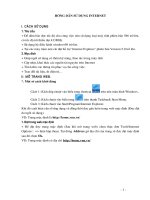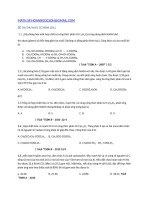E mail security a pocket guide
Bạn đang xem bản rút gọn của tài liệu. Xem và tải ngay bản đầy đủ của tài liệu tại đây (1.08 MB, 100 trang )
E-mail Security
A Pocket Guide
Steven Furnell
Paul Dowland
E-mail Security
E-mail Security
A Pocket Guide
STEVEN FURNELL
PAUL DOWLAND
Every possible effort has been made to ensure that the
information contained in this book is accurate at the time
of going to press, and the publisher and the authors
cannot accept responsibility for any errors or omissions,
however caused. No responsibility for loss or damage
occasioned to any person acting, or refraining from
action, as a result of the material in this publication can
be accepted by the publisher or the authors.
Apart from any fair dealing for the purposes of research
or private study, or criticism or review, as permitted
under the Copyright, Designs and Patents Act 1988, this
publication may only be reproduced, stored or
transmitted, in any form, or by any means, with the prior
permission in writing of the publisher or, in the case of
reprographic reproduction, in accordance with the terms
of licences issued by the Copyright Licensing Agency.
Enquiries concerning reproduction outside those terms
should be sent to the publisher at the following address:
IT Governance Publishing
IT Governance Limited
Unit 3, Clive Court
Bartholomew’s Walk
Cambridgeshire Business Park
Ely
Cambridgeshire
CB7 4EH
United Kingdom
www.itgovernance.co.uk
© Steven Furnell & Paul Dowland 2010
The authors have asserted the rights of the authors under
the Copyright, Designs and Patents Act 1988, to be
identified as the authors of this work.
First published in the United Kingdom in 2010
by IT Governance Publishing.
ISBN 978-1-84928-097-6
PREFACE
E-mail is now an established and increasingly
essential channel of business and personal
communication. As such, safeguarding its
operation and integrity is an issue of widespread
significance. At the same time, e-mail has proven
itself to represent a considerable threat vector,
providing a route for a variety of attacks including
malware, phishing and spam. In addition, e-mail
usage can introduce further risks if not
appropriately guided and managed, with the
potential for confidentiality to be compromised
and reputations to be damaged. With these points
in mind it is relevant for all stakeholders to
consider their role in protecting e-mail and using
the service appropriately.
This guide provides a concise reference to the
main security issues affecting those that deploy
and use e-mail to support their organisations,
considering e-mail in terms of its significance in a
business context, and focusing upon why effective
security policy and safeguards are crucial in
ensuring the viability of business operations. The
resulting coverage encompasses issues of
relevance to end-users, business managers and
technical staff, and this holistic approach is
intended to give each key audience an
understanding of the actions relevant to them, as
well as an appreciation of the issues facing the
other groups.
5
ABOUT THE AUTHORS
Professor Steven Furnell has a significant track
record in information security, through both
personal research and consultancy activity and via
supervised PhD and Masters projects within the
Centre for Security, Communications and Network
Research at the University of Plymouth. He has
authored more than 210 refereed papers in
international journals and conferences, as well as a
variety of commissioned journal articles, book
chapters and books. Specific examples of the latter
include Cybercrime: Vandalising the Information
Society, Addison Wesley, Harlow, Essex (2001),
Computer Insecurity: Risking the System,
Springer, London (2005) and Mobile Security: A
Pocket Guide, IT Governance Publishing, Ely,
Cambs (2009).
Dr Paul Dowland has firsthand practical
experience of administering and securing e-mail
services in his role supporting the Centre for
Security, Communications and Network Research
at the University of Plymouth, as well as teaching
both network- and application-level security
principles and practice at undergraduate and
postgraduate levels. He has also authored/edited
more than 70 publications including 34 peerreviewed papers in journals and international
conferences.
Further details of the Centre for Security,
Communications and Network Research can be
found at: www.plymouth.ac.uk/cscan.
6
ACKNOWLEDGEMENTS
Dedicated to the memory of Lena Furnell ... quite
a fan of e-mail in her later years!
7
CONTENTS
Chapter 1: E-mail: Can we live without it? .... 12
Dependency without a guarantee .................... 14
The implications of dependence ..................... 17
Takeaways ...................................................... 17
Chapter 2: E-mail threats and attacks ............ 19
Mass-mailed malware ..................................... 20
Spams and scams ............................................ 23
There’s something phishy going on ................ 28
Takeaways ...................................................... 32
Chapter 3: Securing the client ......................... 34
General guidelines .......................................... 34
Web-based clients ........................................... 41
Mobile clients ................................................. 42
Takeaways ...................................................... 44
Chapter 4: Safety in transit.............................. 46
Protocols ......................................................... 47
Countermeasures ............................................ 53
Takeaways ...................................................... 54
Chapter 5: Server side security ....................... 55
Firewall ........................................................... 55
Authenticated access ....................................... 56
Connection filtering ........................................ 56
Address filtering ............................................. 60
Content filtering .............................................. 61
Challenge/response ......................................... 62
E-mail gateway ............................................... 63
Relaying .......................................................... 64
UBE by attachment ......................................... 65
Takeaways ...................................................... 66
Chapter 6: E-mail archiving ............................ 68
Archiving because we want to ........................ 69
Archiving because we have to ........................ 71
Takeaways ...................................................... 73
8
Contents
Chapter 7: Ethereal e-mail ............................... 74
Takeaways ...................................................... 76
Chapter 8: Risking our reputation? ................ 78
Going down in history .................................... 79
Just having a laugh? ........................................ 81
Putting it in a policy ........................................ 83
Takeaways ...................................................... 89
Appendix: additional notes .............................. 91
Domain Name System (DNS) ......................... 91
DomainKeys ................................................... 92
Architectures ................................................... 93
Additional Secure Sockets Layer (SSL)
certificate warning examples .......................... 94
Putting it all together ...................................... 96
ITG Resources................................................... 98
9
GLOSSARY OF ABBREVIATIONS
3G
AV
CAPTCHA
CC
DNS
GPG
HTML
HTTP
HTTPS
IMAP
IP
ISP
MD5
MP3
MTA
MX
NDR
PDA
PGP
POP
S/MIME
SMTP
SPF
SSL
TCP
TLS
UA
UBE
URL
3rd Generation
Anti-virus
Completely Automated Public
Turing test to tell Computers and
Humans Apart
Carbon Copy
Domain Name System
GNU Privacy Guard
HyperText Markup Language
HyperText Transfer Protocol
HyperText Transfer Protocol Secure
Internet Message Access Protocol
Internet Protocol
Internet Service Provider
Message-Digest algorithm 5
MPEG-1 or MPEG-2 Audio Layer 3
Message Transfer Agent
Message eXchange
Non Delivery Report
Personal Digital Assistant
Portable Document Format
Pretty Good Privacy
Post Office Protocol
Secure/Multipurpose Internet Mail
Extensions
Simple Mail Transfer Protocol
Sender Policy Framework
Secure Sockets Layer
Transmission Control Protocol
Transport Layer Security
User Agent
Unsolicited Bulk E-mail
Uniform Resource Locator
10
Glossary of Abbreviations
USB
WLAN
Universal Serial Bus
Wireless Local Area Network
11
CHAPTER 1: E-MAIL: CAN WE LIVE
WITHOUT IT?
E-mail fulfils an important role in modern
organisations in terms of facilitating both internal
communications
and
external
relationships.
However, while it offers indisputable benefits, such
significant use introduces inevitable elements of
dependence and exposure. Indeed, from a
business perspective, the mere fact that we now
place such reliance upon e-mail can introduce the
first element of risk, especially when the underlying
technology does not provide a guaranteed service.
It would be no exaggeration to suggest that e-mail
is now the lifeblood of modern business
communications. Indeed, it is conceivable that
some readers may not even have experienced the
pre-e-mail era, when the only options for
circulating a document involved photocopying it
and/or faxing it, and when memos were sent on
paper (and when a cc’d recipient may in fact have
received a genuine carbon copy). At the time of
writing, these other modes of communication have
not entirely disappeared, but they are far less
commonplace and there are likely to be few
modern business environments in which they are
now dominant.
It is now not uncommon to find individuals who
routinely receive hundreds of e-mails per day.
(Whether they reply to them all is another matter!).
Indeed, findings from Radicati Group suggest that
business users in 2009 received an average of 74
messages per day, plus sent an average of 34 of
12
1: E-mail: Can We Live Without It?
their own, and consequently spent 19% of their
working day engaged in e-mail-related activities.1
To give this some context, the overall figure of
108 messages per day was actually down on the
figure for 2008, when respondents had dealt with
an average of 140 messages per day. Radicati’s
analysis attributed the reduction to an
accompanying increase in the business use of
instant messaging and social networks. However,
this should by no means be taken to indicate that
e-mail itself is in decline. Indeed, to quote further
statistics from Radicati, the 1.4 billion e-mail users
of 2009 are set to rise to 1.9 billion by 2013, with
worldwide traffic increasing from 247 billion
messages per day to 507 billion in the same
period.2
Given the importance of the medium, it is no
surprise that e-mail security is now an extremely
significant issue. Indeed, a 2007 report from the
European Network and Information Security
Agency (ENISA) revealed that ‘email and
electronic communications’ was considered to be
the most important area in which organisations
should ensure staff awareness of security topics or
risks.3 The fact that this placed it ahead of a whole
range of other key issues (including physical
security, passwords, Internet security and viruses)
1
Radicati. 2009. Business User Survey, 2009 – Executive
Summary. Radicati Group Inc., November 2009.
2
Radicati. 2009. ‘The Radicati Group Releases “Email
Statistics Report, 2009–2013”’, Press Release, Radicati
Group Inc., 6 May 2009.
3
ENISA. 2007. Information security awareness
initiatives: Current practice and the measurement of
success. European Network and Information Security
Agency, July 2007.
13
1: E-mail: Can We Live Without It?
helps to illustrate just how significant the use of email has now become. Later chapters consequently
focus upon the ways in which both messages and
services ought to be protected. To begin with,
however, attention is turned to the risks that such
reliance upon e-mail can pose in its own right.
Dependency without a guarantee
The reliance upon e-mail has become so engrained
within many businesses that things can no longer
function nearly as well without it. Indeed, in
extreme situations, there are some people that are
so dependent upon e-mail that they literally don’t
know what to do if the system is down, and find
that many of their daily tasks are oriented around
their e-mail. Whether this is a good thing is clearly
open to question, especially given that e-mail itself
is not a completely reliable medium in the first
place. Indeed, while most senders will work on the
assumption that once they have successfully sent
an e-mail it will also be successfully received at
the other end, the reality is that there are several
circumstances in which messages may not actually
reach the recipient as intended. One of the most
common is that they get misclassified as spam
(junk) mail, and either get blocked at the
recipient’s mail server or placed into a junk folder
on their local machine rather than going into the
inbox as normal. As a result, the message may
only be spotted some time later (e.g. if the
recipient does a periodic trawl of their junk folder
to check the messages) or may go unnoticed
altogether (e.g. if the recipient is the sort of person
who just purges their junk mail without looking at
it).
14
1: E-mail: Can We Live Without It?
The underlying cause of the difficulty here is, of
course, the problem posed by genuine spam mail.
This has now become so significant that simply
letting it all through would represent a significant
overhead, in terms of both the technical demands
(e.g. wasted bandwidth and storage) and human
effort (e.g. wasting time having to sift through all
the junk in order to find the messages that actually
matter). As a result, many e-mail systems have
evolved to incorporate spam-filtering techniques,
which try to reduce the burden by looking for
signs of spam messages and then flagging and/or
separating out those that look suspicious.
However, the classification process is far from
perfect, and from the authors’ personal experience
it is not unusual to find one or two legitimate emails per day that have been misclassified as
spam, and which, therefore, end up in the junk
folder rather than the inbox (plus, of course,
occasional spam messages that still manage to
make it through). To illustrate the point, the header
of a related example is shown in Figure 1. The
reasons are not always predictable, but common
causes include e-mails that do not have a
substantial message body (e.g. those that only
include a hyperlink or an attachment) or messages
that have been sent to multiple recipients.
Somewhat ironically then, spam filtering can
effectively become a threat to the overall integrity
of operations if the errors are not identified and
messages get missed as a result.
15
1: E-mail: Can We Live Without It?
Figure 1: A legitimate message, but
misclassified as spam and filed as junk
Unfortunately, being mistakenly treated as spam is
just one of the reasons that things may not go to
plan. Other options that may lead to messaging
failure include:
x
routing problems within the network, with the
consequence that the process times out and the
message never actually finds a path to the
intended destination;
x
messages arriving only to find that the
recipient’s mailbox is full and, therefore,
cannot accommodate them;
x
blocking of particular message types at the
remote end or stripping of attachments,
meaning that recipients do not get to see the
content that was intended.
In some cases the sender may get a message back
to advise them of a problem, but even then the
timeliness of such notifications may vary. For
example, whereas a full mailbox is likely to yield a
fairly immediate auto-reply, delay notifications
may not appear until hours (or even days) after the
original despatch of the message. In the event of
their message being misclassified as spam, it is
unlikely that the sender would receive any
16
1: E-mail: Can We Live Without It?
indication, and so recovering the situation largely
rests with whether or not the recipient checks their
junk mail and/or whether the sender tries to follow
it up later.
The implications of dependence
To answer the question posed by the chapter title,
the likely response from many would now be ‘not
very easily’. It’s easy to become blasé about our
adoption and reliance upon e-mail, because its use
is already so engrained that it seems obvious.
However, what is less certain is whether we have
fully recognised the implications. In fact, whether
we are new or established users, the prevalence of
e-mail ought to raise some important questions
from a security perspective:
x
What risks does it introduce?
x
Do people know how to use it effectively?
x
Do they know how to use it safely?
x
What safeguards can technology provide?
The answers to these and other issues are
addressed as part of the chapters that follow.
Takeaways
¾
Recognise the level of dependency that your
organisation has upon e-mail relative to other
forms of communication, and ensure that
security issues are afforded appropriate
priority accordingly.
17
1: E-mail: Can We Live Without It?
¾
Do not allow the speed and convenience of email to compromise the credibility of business
decisions. If an issue requires proper debate, a
rapid but ill-considered e-mail reply may pose
as much of a threat as a deliberate attack.
¾
Do not assume that e-mail recipients are
guaranteed to receive the messages you
intend for them. Although it works most of the
time, you cannot be sure that a message has
got through until you get a reply or do
something to check.
¾
Recognise that different users may prioritise
and handle e-mails in different ways. If
something requires urgent action or explicit
confirmation then consider that alternative
channels may need to be used.
¾
Ensure that users are aware of the
organisation’s expectations regarding e-mail
usage and frequency of checking (e.g. if they
are expected to keep a watchful eye on
messages, then they need to be advised that
checking once or twice per day is not
sufficient).
¾
Perform periodic checks of junk mail folders to
ensure that relevant and important messages
have not found their way there by mistake.
Once checked, folders can be purged to keep
their size down.
18
CHAPTER 2: E-MAIL THREATS AND
ATTACKS
Alongside the undoubted benefits, a variety of risks
can be introduced via e-mail channels, affecting
individuals, systems and organisations. This
chapter considers problems originating from the
messages themselves, such as spam and phishing,
as well as the potential for messages to become
carriers for malware such as viruses, worms and
Trojan horses. The discussion highlights the threat
vectors, illustrating them with appropriate examples,
alongside advice for reducing the associated risk
and disruption.
E-mail can undoubtedly offer us an easy and
effective means of communication. Unfortunately,
it also represents a significant channel for threats
to both organisations and individuals. Indeed,
many of these are well established and
organisations have already been forced into
providing safeguards against the problems. For
example, 97% of businesses surveyed in the UK’s
2008 Information Security Breaches Survey
(ISBS) filtered incoming e-mail for spam and 95%
scanned it for malware.4 In addition, there are
further issues that can arise from within the
organisation. For instance, of the 16% of ISBS
respondents reporting staff misuse of information
systems, almost half (7%) were related to e-mail
4
BERR. 2008. 2008 Information Security Breaches
Survey – Technical Report. Department for Business
Enterprise & Regulatory Reform, April 2008. URN
08/788.
19
2: E-mail Threats and Attacks
access. Moreover, when considering only the large
organisations (rather than the respondent base as a
whole) the proportion experiencing e-mail misuse
rose to a quarter. In terms of the volume of
associated incidents, approximately half of the
affected respondents were reporting only ‘a few’
during the prior year. However, at the extreme end
of the scale, almost one in ten were reporting
several misuse incidents per day.
The focus of this chapter is primarily placed upon
the threats that may enter the organisation via email, with the problems arising from staff misuse
being more fully pursued in Chapter 8. With this
in mind, a good starting point is the significant
threat posed by e-mail-based malicious code …
Mass-mailed malware
Although Internet-wide incidents had been
experienced before (e.g. the Internet Worm, or
Morris Worm, of 1988 was able to infect the entire
network via a combination of vulnerability
exploits), the mass adoption of e-mail was a
catalyst for ushering in truly large-scale and more
frequent malware incidents. Landmark cases such
as the Melissa virus and the Love Letter worm
were fundamentally possible because they used email as their distribution channel. While later
years have seen fewer celebrity cases of this
nature, the problem has far from disappeared. To
illustrate the point, Figure 2 draws upon data from
MessageLabs and depicts the changing picture
over the past decade, with the worst period having
been in 2004, with an average of one in every
sixteen messages being infected.
20
2: E-mail Threats and Attacks
Figure 2: Proportion of malware-infected email from 2000 to 2009
As a consequence of the threat, e-mail protection
is now a standard feature of antivirus and Internet
security packages, and e-mail clients themselves
now incorporate features to block potentially
suspicious attachments and executable scripts.
However, this is one of the many areas of security
in which technology alone cannot provide the
complete solution. Many malware-related e-mails
(and indeed wider e-mail scams that are discussed
later in the chapter) seek to exploit people via
social
engineering.
For
example,
the
aforementioned Melissa virus claimed to be an
important message containing a document
requested by the recipient,5 whereas (as its name
suggests) the Love Letter worm found success by
5
CERT. 1999. ‘CERT® Advisory CA-1999-04 Melissa
Macro Virus’, 27 March 1999.
www.cert.org/advisories/CA-1999-04.html
21
2: E-mail Threats and Attacks
claiming that its attachment was a love letter.6 In
fact, the methods and guises that malware may
employ are so variable that it is difficult to provide
specific advice to staff beyond exercising caution
with attachments and any messages that do not
contain expected work-related content.
Organisations appear to be fairly well attuned to
the need to protect themselves against incoming
problems, with the aforementioned 2008 ISBS
reporting that 95% scanned incoming e-mail and
web downloads for malware. However, there
appears to be somewhat less recognition of the
importance of scanning outgoing mail, with only
77% claiming to do so. As such, malware that may
have entered the organisation via another route
(e.g. on removable media or an infected laptop)
may then find an unprotected channel for
spreading onwards and outwards to other systems.
In fact, scans of outgoing e-mails can also be
utilised to safeguard against a variety of other
threats relating to content that employees should
not be sending. However, as Figure 3 illustrates,
only a minority of organisations tend to scan for
things other than malware (with the identification
of inappropriate content being the next most likely
target, but still trailing by a considerable margin).
The finding that a fifth of organisations scan for
nothing at all clearly goes some way to explaining
why other organisations still face a considerable
volume of incoming threats.
6
CERT. 2000. ‘CERT® Advisory CA-2000-04 Love
Letter Worm’, 4 May 2000.
www.cert.org/advisories/CA-2000-04.html
22
2: E-mail Threats and Attacks
Figure 3: Things scanned for in outgoing
e-mails (Source: BERR 2008 ISBS)
Technical countermeasures for handling malware
(plus the other threats mentioned here) are
discussed in later chapters.
Spams and scams
While e-mail has undoubtedly been a boon to both
business and personal communications, it has also
provided an easy route for the considerable
volume of unwanted messages that now reach us.
While junk mail existed in pre-e-mail days, the
provision of the electronic channel means that it
can now address a vast audience, and it can do so
quickly, in high volumes and at minimal cost.
Indeed, the sheer ease of sending messages has
amplified the junk mail problem out of all
recognition, with the knock-on consequence that
virtually all e-mail users are familiar with the
nuisance posed by spam. Consequently, as
mentioned in Chapter 1, spam-filtering
technologies are now a standard element of e-mail
23
2: E-mail Threats and Attacks
provision, and it has been estimated that managing
the problem costs upwards of US$1.8 million per
annum for a typical 1,000-user organisation.7 As
an aside, spam is also an issue to be aware of in
relation to messages being sent, in order to ensure
that we are not contributing to the problem. This is
especially relevant in view of increasing anti-spam
legislation (e.g. the US CAN-SPAM Act8), which
can hold organisations accountable for sending
spam and levy fines if they misbehave.
The nature of the unwanted messages that we can
receive in this manner is variable. While many still
fit into the mould of advertising-related junk mail
that can still be regularly received by post, they are
accompanied by more insidious messages that
seek to dupe and defraud the recipients. A
common example here is the so-called advance fee
fraud (also referred to as 419 scams after the
related article of the Nigerian criminal code) in
which recipients are promised a large sum of
money in return for assisting with a financial
transaction. The example in Figure 4 is typical of
the genre, with a combined appeal to the trust and
greed of the recipient (combined in this case with
the potential added incentive of becoming the
guardian of a 20-year-old woman). Within the
rather lengthy body of the message, a notable
7
Radicati. 2009. ‘The Radicati Group Releases “Email
Statistics Report, 2009–2013”’, Press Release, Radicati
Group Inc., 6 May 2009.
8
FTC. 2009. ‘The CAN-SPAM Act: A Compliance
Guide for Business’, Federal Trade Commission,
September 2009.
www.ftc.gov/bcp/edu/pubs/business/ecommerce/bus61.sh
tm (accessed 1 September 2010).
24
2: E-mail Threats and Attacks
aspect is the mention of ‘Tax you will pay during
the transfer’. This is basically an indication of the
ensuing sting, when anyone responding to the
message and expressing interest will find that there
are various up-front fees to be paid before any
money can actually be transferred to their account.
And, of course, the reality is that, if things were
allowed to proceed, this would be the only money
that would ever actually change hands.
From: Miss.Lucy Naumi
Country: Cote d’Ivoire
DEAR FRIEND
My Dear,I saw your contact through the
Internet directory and after going through your
profile my instinct advised me to contact you,
while I was searching for someone who can
assist me in this great time of need, someone
who can help me out of this my present
predicament.Please, carefully read below to
understand my plight. I need someone, whom
I can trust and someone who would be also
sincere to me. I am writing to you hoping that
you would accord and give me the needed
help and assistance that I am looking for.
My name is Lucy Naumi, I’m the only
Child/daughter of late mr. and mrs. Macoli
Naumi. My father was a very Wealthy Timber
& African art Merchant, the Chairman board of
trustee, of all farm products exporters. (C.F.E)
here in Abidjan the Economic Capital of Cote
d’Ivoire , before the death of my father on
28th August 2009. He was poison by his
business associate due to he was a
25









